| 编辑推荐: |
文章介绍了神经网络的基础知识,并举例说明了如何搭建神经网络,如何训练神经网络以及一种优化算法随机梯度下降(SGD)等。
本文来自于csdn,由火龙果软件Luca编辑、推荐。 |
|
从零开始学习神经网络
搭建基本模块—神经元
在说神经网络之前,我们讨论一下神经元(Neurons),它是神经网络的基本单元。神经元先获得输入,然后执行某些数学运算后,再产生一个输出。比如一个2输入神经元的例子:
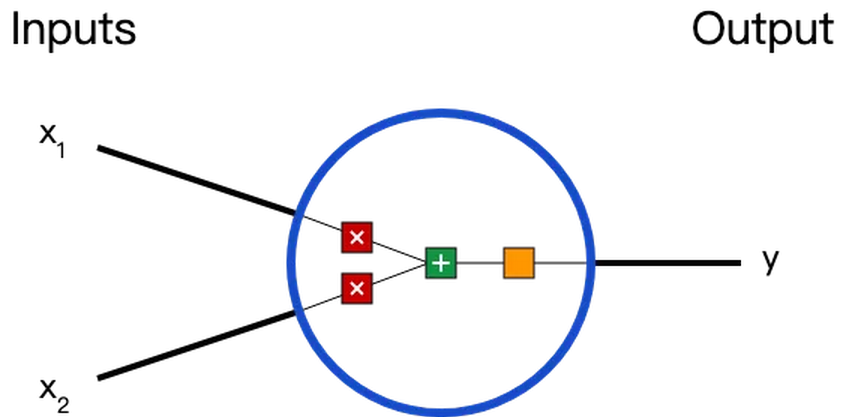
在这个神经元里,输入总共经历了3步数学运算,
先将输入乘以权重(weight):

最后经过激活函数(activation function)处理得到输出:

激活函数的作用是将无限制的输入转换为可预测形式的输出。一种常用的激活函数是sigmoid函数:
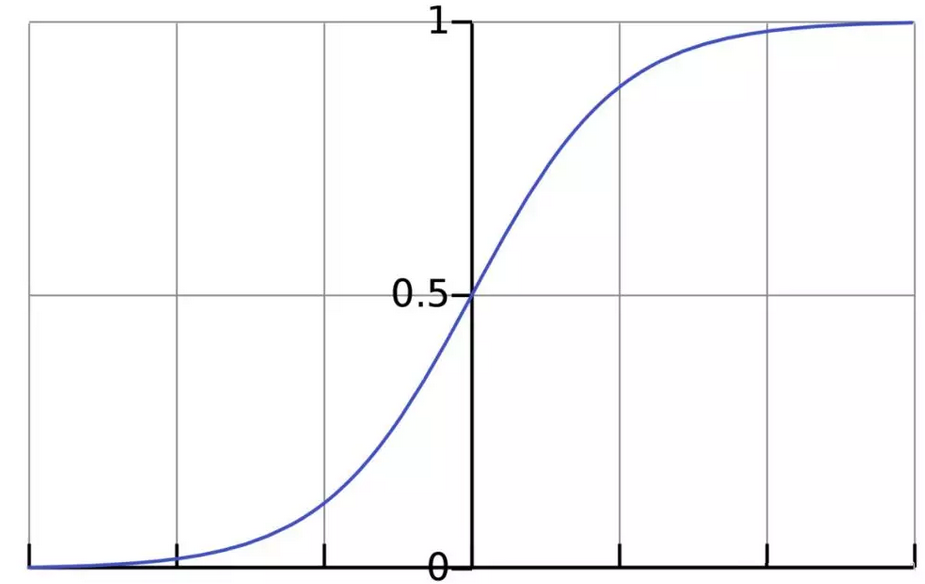
sigmoid函数的输出介于0和1,我们可以理解为它把 (-∞,+∞)
范围内的数压缩到 (0, 1)以内。正值越大输出越接近1,负向数值越大输出越接近0。
举个例子,上面神经元里的权重和偏置取如下数值:w=[0,1];b=4
w=[0,1] 是w1=0,w2=1
的向量形式写法。给神经元一个输入x=[2,3] 可以用向量点积的形式把神经元的输出计算出来:

以上步骤的Python代码是:
import numpy
as np
def sigmoid(x):
# our activation function: f(x) = 1 / (1 * e^(-x))
return 1 / (1 + np.exp(-x))
class Neuron():
def __init__(self, weights, bias):
self.weights = weights
self.bias = bias
def feedforward(self, inputs):
# weight inputs, add bias, then use the activation
function
total = np.dot(self.weights, inputs) + self.bias
return sigmoid(total)
weights = np.array([0, 1]) # w1 = 0, w2 = 1
bias = 4
n = Neuron(weights, bias)
# inputs
x = np.array([2, 3]) # x1 = 2, x2 = 3
print(n.feedforward(x)) # 0.9990889488055994 |
搭建神经网络
神经网络就是把一堆神经元连接在一起,下面是一个神经网络的简单举例:
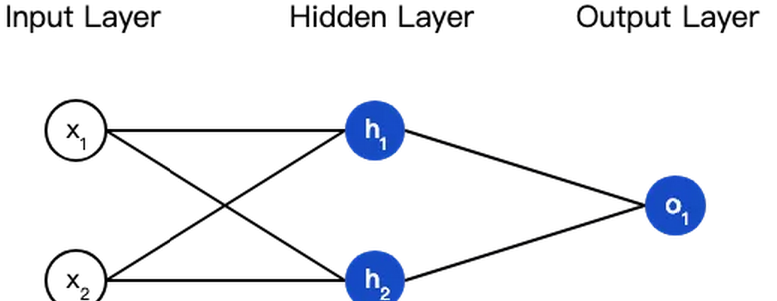
这个网络有2个输入、一个包含2个神经元的隐藏层(h1和h2)、包含1个神经元的输出层o1。
隐藏层是夹在输入输入层和输出层之间的部分,一个神经网络可以有多个隐藏层。
把神经元的输入向前传递获得输出的过程称为前馈(feedforward)。
我们假设上面的网络里所有神经元都具有相同的权重w=[0,1] 和偏置b=0
,激活函数都是sigmoid {sigmoid}sigmoid,那么我们会得到什么输出呢?

以下是实现代码:
class OurNeuralNetworks():
"""
A neural network with:
- 2 inputs
- a hidden layer with 2 neurons (h1, h2)
- an output layer with 1 neuron (o1)
Each neural has the same weights and bias:
- w = [0, 1]
- b = 0
"""
def __init__(self):
weights = np.array([0, 1])
bias = 0
# The Neuron class here is from the previous section
self.h1 = Neuron(weights, bias)
self.h2 = Neuron(weights, bias)
self.o1 = Neuron(weights, bias)
def feedforward(self, x):
out_h1 = self.h1.feedforward(x)
out_h2 = self.h2.feedforward(x)
# The inputs for o1 are the outputs from h1 and
h2
out_o1 = self.o1.feedforward(np.array([out_h1,
out_h2]))
return out_o1
network = OurNeuralNetworks()
x = np.array([2, 3])
print(network.feedforward(x)) # 0.7216325609518421 |
训练神经网络
现在我们已经学会了如何搭建神经网络,现在再来学习如何训练它,其实这是一个优化的过程。
假设有一个数据集,包含4个人的身高、体重和性别:

现在我们的目标是训练一个网络,根据体重和身高来推测某人的性别。
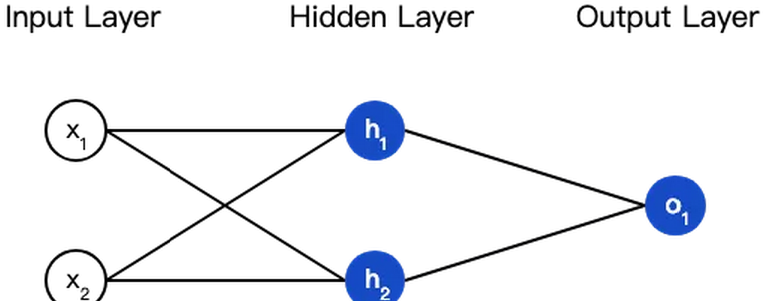
为了简便起见,我们将每个人的身高、体重减去一个固定数值,把性别男定义为1、性别女定义为0。

在训练神经网络之前,我们需要有一个标准定义它到底好不好,以便我们进行改进,这就是损失(loss)。
比如用均方误差(MSE)来定义损失:

n 是样本的数量,在上面的数据集中是4;
y 代表人的性别,男性是1,女性是0;
ytrue 是变量的真实值,ypred是变量的预测值。
顾名思义,均方误差就是所有数据方差的平均值,我们不妨就把它定义为损失函数。预测结果越好,损失就越低,训练神经网络就是将损失最小化。
如果上面网络的输出一直是0,也就是预测所有人都是男性,那么损失是

计算损失函数的代码如下:
def mse_loss(y_true,
y_pred):
# y_true and y_pred are numpy arrays of the same
length
return ((y_true - y_pred) ** 2).mean()
y_true = np.array([1, 0, 0, 1])
y_pred = np.array([0, 0, 0, 0])
print(mse_loss(y_true, y_pred)) # 0.5 |
减少神经网络损失
这个神经网络不够好,还要不断优化,尽量减少损失。我们知道,改变网络的权重和偏置可以影响预测值,但我们应该怎么做呢?
为了简单起见,我们把数据集缩减到只包含Alice一个人的数据。于是损失函数就剩下Alice一个人的方差:

预测值是由一系列网络权重和偏置计算出来的:
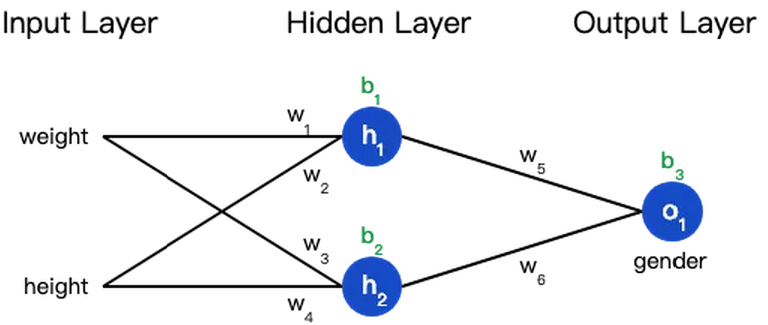
所以损失函数实际上是包含多个权重、偏置的多元函数:
L(w1,w2,w3,w4,w5,w6,b1,b2,b3)
(注意!前方高能!需要你有一些基本的多元函数微分知识,比如偏导数、链式求导法则。)
如果调整一下w1,损失函数是会变大还是变小?我们需要知道偏导数 是正是负才能回答这个问题。 是正是负才能回答这个问题。
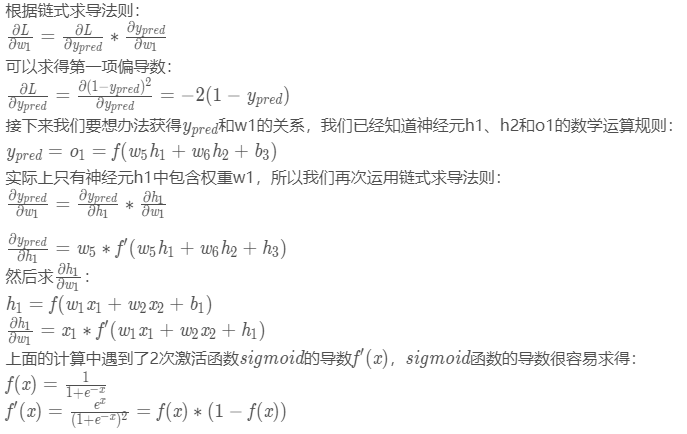
总的链式求导公式:

这种向后计算偏导数的系统称为反向传播(backpropagation)。
上面的数学符号太多,下面我们带入实际数值来计算一下。h1、h2和o1

神经网络的输出y=0.524,没有显示出强烈的是男(1)是女(0)的证据。现在的预测效果还很不好。

这个结果告诉我们:如果增大w1,损失函数L会有一个非常小的增长。
随机梯度下降
下面将使用一种称为随机梯度下降(SGD)的优化算法,来训练网络。
经过前面的运算,我们已经有了训练神经网络所有数据。但是该如何操作?SGD定义了改变权重和偏置的方法:

η是一个常数,称为学习率(learning rate),它决定了我们训练网络速率的快慢。将w1
减去 ,就等到了新的权重w1
。 ,就等到了新的权重w1
。
如果我们用这种方法去逐步改变网络的权重w和偏置b,损失函数会缓慢地降低,从而改进我们的神经网络。
训练流程如下:
从数据集中选择一个样本;
计算损失函数对所有权重和偏置的偏导数;
使用更新公式更新每个权重和偏置;
回到第1步。
Python代码实现这个过程:
def sigmoid(x):
# Sigmoid activation function: f(x) = 1 / (1 +
e^(-x))
return 1 / (1 + np.exp(-x))
def deriv_sigmoid(x):
# Derivative of sigmoid: f'(x) = f(x) * (1 - f(x))
fx = sigmoid(x)
return fx * (1 - fx)
def mse_loss(y_true, y_pred):
# y_true and y_pred are numpy arrays of the same
length
return ((y_true - y_pred) ** 2).mean()
class OurNeuralNetwork():
"""
A neural network with:
- 2 inputs
- a hidden layer with 2 neurons (h1, h2)
- an output layer with 1 neuron (o1)
*** DISCLAIMER ***
The code below is intend to be simple and educational,
NOT optimal.
Real neural net code looks nothing like this.
Do NOT use this code.
Instead, read/run it to understand how this specific
network works.
"""
def __init__(self):
# weights
self.w1 = np.random.normal()
self.w2 = np.random.normal()
self.w3 = np.random.normal()
self.w4 = np.random.normal()
self.w5 = np.random.normal()
self.w6 = np.random.normal()
# biases
self.b1 = np.random.normal()
self.b2 = np.random.normal()
self.b3 = np.random.normal()
def feedforward(self, x):
# x is a numpy array with 2 elements, for example
[input1, input2]
h1 = sigmoid(self.w1 * x[0] + self.w2 * x[1] +
self.b1)
h2 = sigmoid(self.w3 * x[0] + self.w4 * x[1] +
self.b2)
o1 = sigmoid(self.w5 * h1 + self.w6 * h2 + self.b3)
return o1
def train(self, data, all_y_trues):
"""
- data is a (n x 2) numpy array, n = # samples
in the dataset.
- all_y_trues is a numpy array with n elements.
Elements in all_y_trues correspond to those in
data.
"""
learn_rate = 0.1
epochs = 1000 # number of times to loop through
the entire dataset
for epoch in range(epochs):
for x, y_true in zip(data, all_y_trues):
# - - - Do a feedforward (we'll need these values
later)
sum_h1 = self.w1 * x[0] + self.w2 * x[1] + self.b1
h1 = sigmoid(sum_h1)
sum_h2 = self.w3 * x[0] + self.w4 * x[1] + self.b2
h2 = sigmoid(sum_h2)
sum_o1 = self.w5 * x[0] + self.w6 * x[1] + self.b3
o1 = sigmoid(sum_o1)
y_pred = o1
# - - - Calculate partial derivatives.
# - - - Naming: d_L_d_w1 represents "partial
L / partial w1"
d_L_d_ypred = -2 * (y_true - y_pred)
# Neuron o1
d_ypred_d_w5 = h1 * deriv_sigmoid(sum_o1)
d_ypred_d_w6 = h2 * deriv_sigmoid(sum_o1)
d_ypred_d_b3 = deriv_sigmoid(sum_o1)
d_ypred_d_h1 = self.w5 * deriv_sigmoid(sum_o1)
d_ypred_d_h2 = self.w6 * deriv_sigmoid(sum_o1)
# Neuron h1
d_h1_d_w1 = x[0] * deriv_sigmoid(sum_h1)
d_h1_d_w2 = x[1] * deriv_sigmoid(sum_h1)
d_h1_d_b1 = deriv_sigmoid(sum_h1)
# Neuron h2
d_h2_d_w3 = x[0] * deriv_sigmoid(sum_h2)
d_h2_d_w4 = x[0] * deriv_sigmoid(sum_h2)
d_h2_d_b2 = deriv_sigmoid(sum_h2)
# - - - update weights and biases
# Neuron o1
self.w5 -= learn_rate * d_L_d_ypred * d_ypred_d_w5
self.w6 -= learn_rate * d_L_d_ypred * d_ypred_d_w6
self.b3 -= learn_rate * d_L_d_ypred * d_ypred_d_b3
# Neuron h1
self.w1 -= learn_rate * d_L_d_ypred * d_ypred_d_h1
* d_h1_d_w1
self.w2 -= learn_rate * d_L_d_ypred * d_ypred_d_h1
* d_h1_d_w2
self.b1 -= learn_rate * d_L_d_ypred * d_ypred_d_h1
* d_h1_d_b1
# Neuron h2
self.w3 -= learn_rate * d_L_d_ypred * d_ypred_d_h2
* d_h2_d_w3
self.w4 -= learn_rate * d_L_d_ypred * d_ypred_d_h2
* d_h2_d_w4
self.b2 -= learn_rate * d_L_d_ypred * d_ypred_d_h2
* d_h2_d_b2
# - - - Calculate total loss at the end of each
epoch
if epoch % 10 == 0:
y_preds = np.apply_along_axis(self.feedforward,
1, data)
loss = mse_loss(all_y_trues, y_preds)
print("Epoch %d loss: %.3f", (epoch,
loss))
# Define dataset
data = np.array([
[-2, -1], # Alice
[25, 6], # Bob
[17, 4], # Charlie
[-15, -6] # diana
])
all_y_trues = np.array([
1, # Alice
0, # Bob
0, # Charlie
1 # diana
])
# Train our neural network!
network = OurNeuralNetwork()
network.train(data, all_y_trues) |
随着学习过程的进行,损失函数逐渐减小。
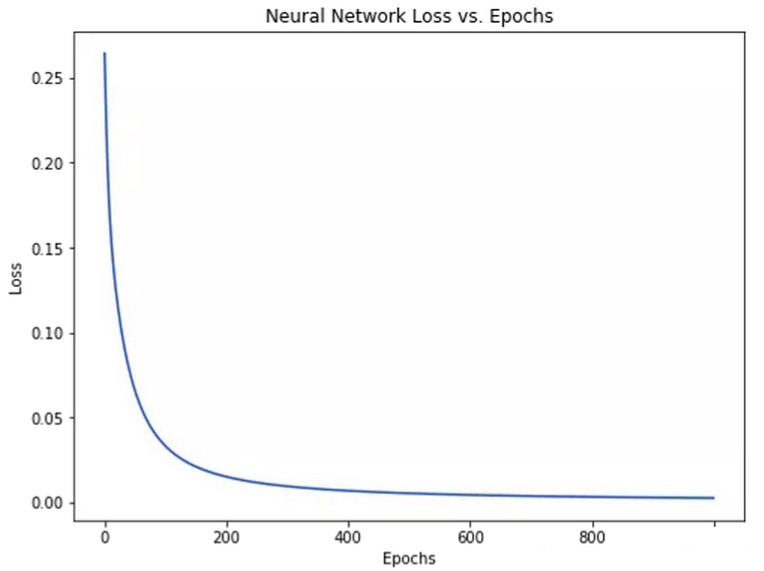
现在我们可以用它来推测出每个人的性别了:
# Make some predictions
emily = np.array([-7, -3]) # 128 pounds, 63 inches
frank = np.array([20, 2]) # 155 pounds, 68 inches
print("Emily: %.3f" % network.feedforward(emily))
# 0.951 - F
print("Frank: %.3f" % network.feedforward(frank))
# 0.039 - M |
|